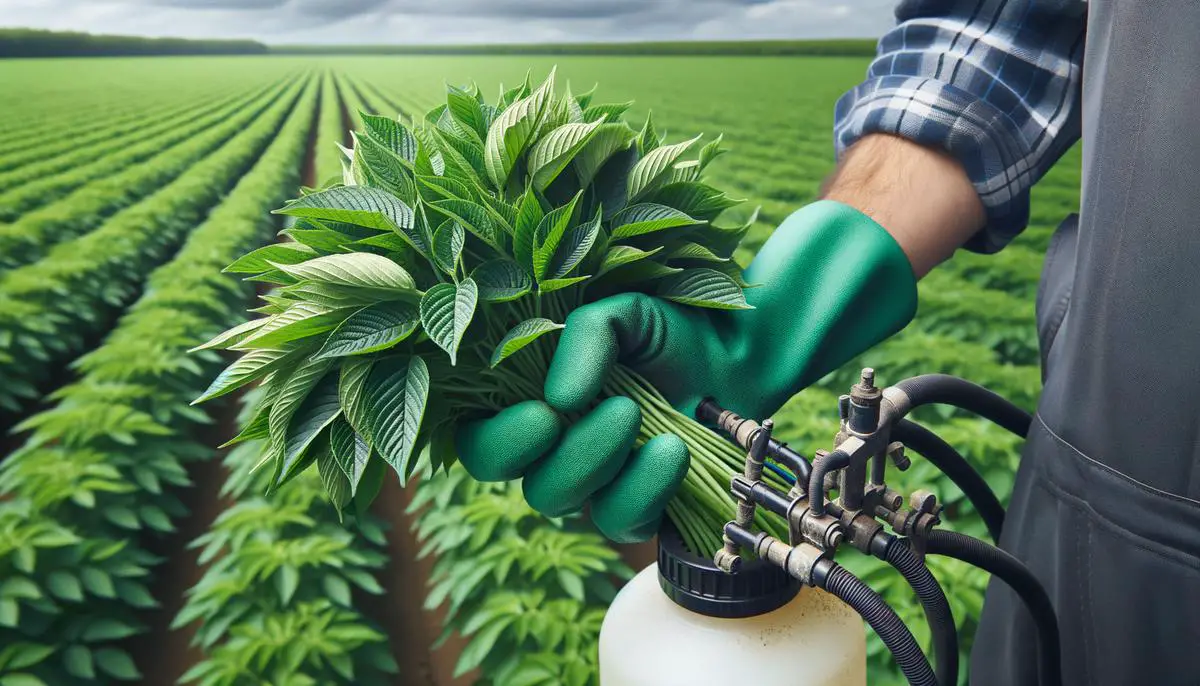Will Roundup Kill Plants?🌿💀 Mastering Roundup Without Damaging Your Plants!

Understanding Glyphosate and Its Effects
At its core, glyphosate is a broad-spectrum systemic herbicide. This means that unlike some weed killers that might only target certain types of plants or only affect the surface, glyphosate has a more comprehensive approach. It penetrates through the green parts of plants—mainly leaves—and courses through the entire system.
Glyphosate inhibits a crucial pathway known as the shikimate pathway, which is pivotal for synthesizing essential amino acids in plants. Without these amino acids, plants cannot produce proteins necessary for growth. Consequently, the plant withers and dies.
The application of glyphosate extends beyond just eliminating pesky weeds from gardens and lawns; it plays a significant role in agricultural practices.
Crops genetically engineered to be resistant to glyphosate allow farmers to apply it without harming their produce. This highlights a dual nature of glyphosate—it’s a tool that can bring about both agricultural efficiency and environmental debates.
Glyphosate binds tightly to soil particles. This property limits its mobility, which theoretically reduces the risk of contaminating groundwater—a crucial aspect considering our pressing need to preserve water quality.
While understanding its utility, we must also navigate through the controversies surrounding glyphosate. Its effectiveness comes with questions about environmental impact and human health concerns.
Regulatory bodies like the U.S. Environmental Protection Agency (EPA) conclude that glyphosate is safe when used as directed, reinforcing the importance of following guidelines meticulously.1
However, contrasting viewpoints from entities like the International Agency on the Research for Cancer (IARC) call for a cautious approach, listing glyphosate as “probably carcinogenic to humans” based on certain studies.2
This juxtaposition of views emphasizes the importance of informed decision-making in its application, pushing us toward a balance of utilization and safety awareness.
Ultimately, glyphosate emerges as both a symbol of modern agricultural advancement and a topic of vibrant debate. Its efficacy is undeniable, but so is the responsibility that accompanies its use—a multifaceted conversation that requires thoughtful engagement and an understanding of the science at play.
As caretakers of our environments, taking an informed stance will always be our best tool in adapting to the ever-evolving discussion around products like glyphosate.

Safe Use of Roundup in the Garden
Whether you have roses that seem to beg for just a bit more sun every morning or carrots that refuse to quit, keeping the garden happy is the goal of any devoted gardener. You love your plants, from the towering sunflowers down to the stubborn lettuce.
It’s no secret that managing weeds is part of the process, and sometimes, that might mean using a helping hand from products like Roundup. Before you go charging into battle, weed sprayer in hand, let’s chat about using Roundup without turning your garden into an unintended casualty.
Get to know the area where you’re planning to wage war on those weeds. If your garden plants are mingling closely with the unwanted guests, you’re going to need to approach this with precision.
Here’s your plan of attack:
- Shielding Your Darlings: Use physical barriers to protect your plants. Cardboard, plastic sheets, or even a makeshift shield out of a milk jug can work wonders to keep the good stuff safe while you direct the spray exactly where you need it to go—right at those pesky weeds.
- Timing is Everything: Choose a calm day for your application. Even a gentle breeze can carry Roundup to places it was never invited.
- Precision Techniques: If you’re dealing with tight spaces or just a few bad apples in the garden patch, consider ditching the sprayer for a more surgical tool—a simple paintbrush or a sponge applicator. Dipping it in Roundup and carefully touching it to the leaves of the weeds brings accuracy to your work.
- Understanding the Fallout: Be mindful of where Roundup can go post-application. It can make its way to non-target plants through soil or by clinging onto your tools. A thorough cleaning of your tools—shoes, gloves, etc.—is crucial to avoid unintentional casualties.
- Recovery Operation: Once the weeds are wilting, give your garden plants some TLC. Water them well and ensure they are taken care of. It’s all about restoring the balance and ensuring your garden knows who’s boss (hint: it’s you, with a little help).
Managing weeds is a bit of a balancing act. With the right preparation and care, even powerful tools like Roundup can find a place in the ensemble without turning the performance into a tragedy.
After all, every plant in your garden has a role to play, and your job is to ensure the show must go on, beautifully and bountifully. Remember, in the theater of gardening, being armed with knowledge and acting with thoughtfulness turns you from a mere player into a director of the verdant realms that await just outside your back door.

Alternatives to Chemical Weed Control
Battling bothersome weeds doesn’t always require reaching for chemical herbicides. In fact, many gardeners are finding joy and success in non-chemical methods to control weeds, safeguarding both their gardens and the environment.
Let’s explore some tried-and-true strategies to manage those pesky plants without relying on herbicides.
Mulch Over Matter
One of the simplest yet most effective ways to suppress weeds is to use mulch. Lay down organic mulch – think straw, wood chips, or even grass clippings – around your plants. This not only blocks light from reaching weed seeds but also enriches your soil as it decomposes.
About 2-3 inches should do the trick, but remember, too much of a good thing can also be bad. Keep it just right to avoid moisture issues.
Grow Dense, Grow Strong
Planting your garden plants closer together crowds out weeds by denying them light and space to grow. Consider companion planting, which not only maximizes space but supports plant health too. This method brings out the best in your garden by reducing room for weeds to spread their roots.
Boiling Water: The Weed Scorcher
Boiling water poured directly onto weed growth is an instant weed wilt. This method works best on driveway or walkway cracks, where it’s unlikely to harm desired plants. Use caution and aim carefully to avoid any plant casualties.
Vinegar: Not Just for Salads
Household vinegar can be a potent herbicide against young weeds. The acetic acid burns weed leaves upon contact. It’s best used during a sunny day for maximum impact. Remember, it’s non-selective and might need multiple applications for tougher weeds. Mix with water for a less concentrated solution, but always test on a small area first.
Elbow Grease: The Classic Approach
Never underestimate the power of pulling weeds by hand. It’s most effective when the soil is moist after rain or watering. Use gardening gloves and ensure you get as much of the root as possible. For the tougher customers, a digging fork can loosen soil without disturbing too much of your plant’s roots.
Corn Gluten Meal
A natural pre-emergent herbicide option is corn gluten meal. It prevents weed seeds from germinating without harmful chemicals.3 Apply it early spring for common garden and lawn weeds but ensure your desired plants are established since it inhibits seed growth indiscriminately.
By taking these steps, you’re not just removing weeds; you’re giving your garden a healthy foundation free from chemicals—benefiting not just your green space but the larger ecosystem as well. Integrating these methods can lead to a flourishing garden that’s vibrant and, more importantly, sustainable.
Why not give these techniques a try? The results might just surprise you, bringing peace and pride in knowing you’re gardening smartly and safely for all, from tiny insects to big, bumbling bees.

At the heart of our discussion on glyphosate is a call for informed decision-making. Recognizing its undeniable efficacy in controlling weeds must be balanced with an awareness of its potential impacts.
By engaging thoughtfully with this topic, we equip ourselves to make choices that support both our immediate gardening goals and the long-term health of our environment.
- US Environmental Protection Agency. Glyphosate. Updated February 16, 2022. Accessed May 23, 2023.
- International Agency for Research on Cancer. IARC Monographs Volume 112: evaluation of five organophosphate insecticides and herbicides. Lyon, France; 2015. Accessed May 23, 2023.
- Abouziena HFH, Haggag WM. Weed control in clean agriculture: A review. Planta Daninha. 2016;34(2):249-265.
